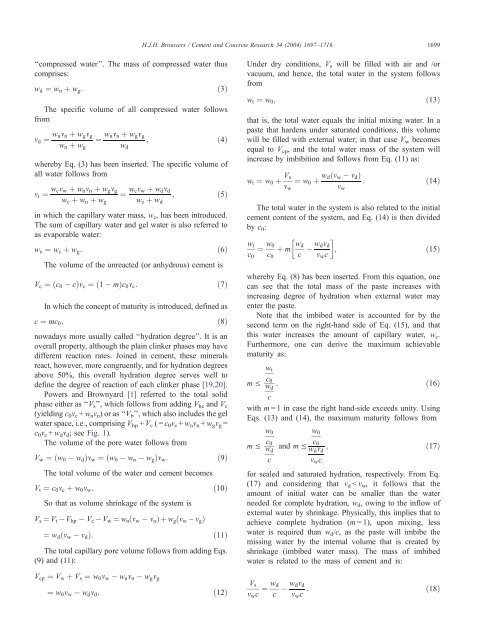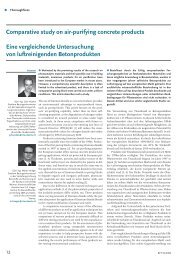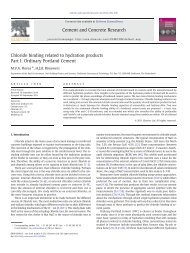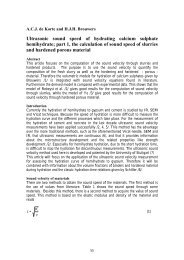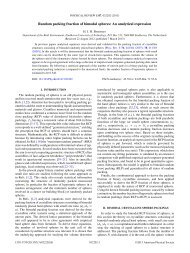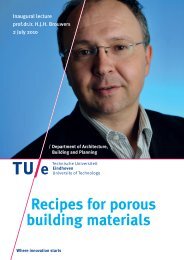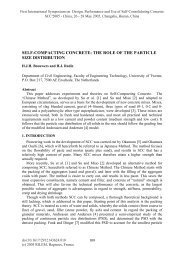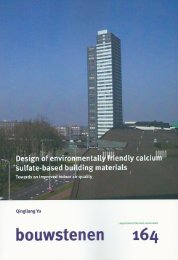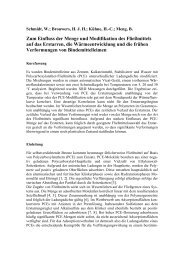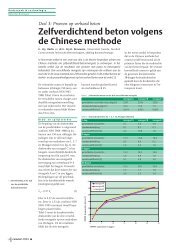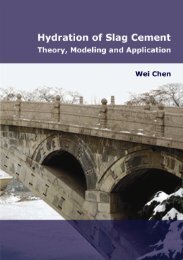The work of Powers and Brownyard revisited: Part 1 - Jos Brouwers
The work of Powers and Brownyard revisited: Part 1 - Jos Brouwers
The work of Powers and Brownyard revisited: Part 1 - Jos Brouwers
You also want an ePaper? Increase the reach of your titles
YUMPU automatically turns print PDFs into web optimized ePapers that Google loves.
H.J.H. <strong>Brouwers</strong> / Cement <strong>and</strong> Concrete Research 34 (2004) 1697–1716 1699‘‘compressed water’’. <strong>The</strong> mass <strong>of</strong> compressed water thuscomprises:w d ¼ w n þ w g :ð3Þ<strong>The</strong> specific volume <strong>of</strong> all compressed water followsfromm d ¼ w nm n þ w g m gw n þ w g¼ w nm n þ w g m gw d; ð4Þwhereby Eq. (3) has been inserted. <strong>The</strong> specific volume <strong>of</strong>all water follows fromm t ¼ w cm w þ w n m n þ w g m gw c þ w n þ w g¼ w cm w þ w d m dw c þ w d; ð5Þin which the capillary water mass, w c , has been introduced.<strong>The</strong> sum <strong>of</strong> capillary water <strong>and</strong> gel water is also referred toas evaporable water:w e ¼ w c þ w g :<strong>The</strong> volume <strong>of</strong> the unreacted (or anhydrous) cement isð6ÞV c ¼ðc 0 cÞm c ¼ð1 mÞc 0 m c : ð7ÞIn which the concept <strong>of</strong> maturity is introduced, defined asc ¼ mc 0 ;ð8Þnowadays more usually called ‘‘hydration degree’’. It is anoverall property, although the plain clinker phases may havedifferent reaction rates. Joined in cement, these mineralsreact, however, more congruently, <strong>and</strong> for hydration degreesabove 50%, this overall hydration degree serves well todefine the degree <strong>of</strong> reaction <strong>of</strong> each clinker phase [19,20].<strong>Powers</strong> <strong>and</strong> <strong>Brownyard</strong> [1] referred to the total solidphase either as ‘‘V s ’’, which follows from adding V hc <strong>and</strong> V c(yielding c 0 m c + w n m n )oras‘‘V b ’’, which also includes the gelwater space, i.e., comprising V hp + V c (=c 0 m c + w n m n + w g m g =c 0 m c + w d m d ; see Fig. 1).<strong>The</strong> volume <strong>of</strong> the pore water follows fromV w ¼ðw 0 w d Þm w ¼ðw 0 w n w g Þm w : ð9Þ<strong>The</strong> total volume <strong>of</strong> the water <strong>and</strong> cement becomesV t ¼ c 0 m c þ w 0 m w :So that as volume shrinkage <strong>of</strong> the system isV s ¼ V t V hp V c V w ¼ w n ðm w m n Þþw g ðm w m g Þð10Þ¼ w d ðm w m d Þ: ð11Þ<strong>The</strong> total capillary pore volume follows from adding Eqs.(9) <strong>and</strong> (11):Under dry conditions, V s will be filled with air <strong>and</strong> /orvacuum, <strong>and</strong> hence, the total water in the system followsfromw t ¼ w 0 ;ð13Þthat is, the total water equals the initial mixing water. In apaste that hardens under saturated conditions, this volumewill be filled with external water; in that case V w becomesequal to V cp , <strong>and</strong> the total water mass <strong>of</strong> the system willincrease by imbibition <strong>and</strong> follows from Eq. (11) as:w t ¼ w 0 þ V s¼ w 0 þ w dðm w m d Þ: ð14Þm w m w<strong>The</strong> total water in the system is also related to the initialcement content <strong>of</strong> the system, <strong>and</strong> Eq. (14) is then dividedby c 0 :w t¼ w 0þ m w dc 0 c 0 cw d m dm w c; ð15Þwhereby Eq. (8) has been inserted. From this equation, onecan see that the total mass <strong>of</strong> the paste increases withincreasing degree <strong>of</strong> hydration when external water mayenter the paste.Note that the imbibed water is accounted for by thesecond term on the right-h<strong>and</strong> side <strong>of</strong> Eq. (15), <strong>and</strong> thatthis water increases the amount <strong>of</strong> capillary water, w c .Furthermore, one can derive the maximum achievablematurity as:m Vw tc 0w d; ð16Þcwith m = 1 in case the right h<strong>and</strong>-side exceeds unity. UsingEqs. (13) <strong>and</strong> (14), the maximum maturity follows fromm Vw 0c 0w dc<strong>and</strong> m Vw 0c 0w d m d; ð17Þm w cfor sealed <strong>and</strong> saturated hydration, respectively. From Eq.(17) <strong>and</strong> considering that m d < m w , it follows that theamount <strong>of</strong> initial water can be smaller than the waterneeded for complete hydration, w d , owing to the inflow <strong>of</strong>external water by shrinkage. Physically, this implies that toachieve complete hydration (m = 1), upon mixing, lesswater is required than w d /c, as the paste will imbibe themissing water by the internal volume that is created byshrinkage (imbibed water mass). <strong>The</strong> mass <strong>of</strong> imbibedwater is related to the mass <strong>of</strong> cement <strong>and</strong> is:V cp ¼ V w þ V s ¼ w 0 m w w n m n w g m g¼ w 0 m w w d m d : ð12ÞV sm w c ¼ w dcw d m dm w c :ð18Þ


